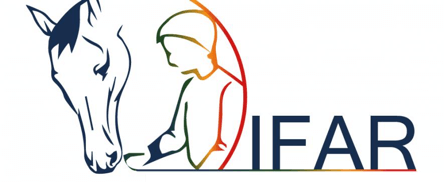The International Forum for the Aftercare of Racehorses (IFAR) announced 19 July that the third episode of the IFAR video magazine is now available. It features the important work retired racehorses are doing in the realm of human therapy. The full episode, as well as a highlight reel, can be found on the IFAR website as well as on IFAR’s YouTube channel.
The short film demonstrates how former racehorses are having a positive and profound effect on humans, whether they be aspiring Paralympians, military veterans, or prisoners. There is mounting evidence to show that retired racehorses are particularly well-suited to providing equine assisted services and equine assisted therapy, delivering life changing support to people affected by physical and/or mental health conditions.
Programs related to equine assisted therapies from all across the globe are highlighted in the new video magazine, including BraveHearts, Equine Pathways, HorseBack UK, Racing Hearts, Racing to Relate, and the Thoroughbred Retirement Foundation (TRF).
Research conducted by Racing to Relate at the University of Bristol, together with a range of case studies from around the world, has identified that Thoroughbreds, more than other breeds, possess the characteristics that make them well-equipped to perform in such valuable roles. The initial findings of the Racing to Relate research were recently unveiled at a symposium entitled the ‘Universal Language of the Horse’ in Deauville, France.
“The study we’re carrying out at the University of Bristol for Racing to Relate started in 2021 and is about the selection, education, welfare of the Thoroughbred in equine assisted services programmes,” said Claire Neveux. “We had 125 respondents from all over the world. From which we gathered very detailed information on 427 horses, including 57 Thoroughbreds.
“Thoroughbreds have very specific characteristics that make them interesting for equine assisted services. The first one is reactivity. Practitioners like horses to be reactive because when the horse reacts, he interacts with the person, and this is very helpful in the work to benefit people. According to all respondents, experience is also very important, and they said that some of their clients relate to the past experience of Thoroughbreds. Another characteristic that was cited by correspondents is their sensitivity. We don’t yet know what is behind this yet, and that’s something we want to explore in phase two.”
Meanwhile, case studies in Australia, the United Kingdom, and the United States have also found former racehorses to be an outstanding breed of horse in terms of equine assisted services.
Racing Hearts is an equine assisted psychology and counselling practice based in Melbourne, and it also runs programmes in other Australian states. Its mental health practitioners see anywhere between 200-300 clients per week, mainly people in the local communities who are struggling with the challenges of mental health and stress.
“Probably about 99% of our therapy team are retired racehorses, and we find that the retired racehorses in comparison to the two small ponies we have are absolutely the best breed for equine assisted therapy,” said Lisa Coffey, founder of Racing Hearts and an equine assisted services practitioner. “Our youngest clients are between 6 and 7 years of age, and our eldest clients are in their 70s. So, we see people with a whole range of challenges. Thoroughbreds are so sensitive and they’re so in-tune with humans because they’ve seen so much in their racing career.”
Jock Hutchison founded the Aberdeen-based HorseBack UK in 2009 with the aim of helping wounded military veterans by introducing them to horses.
“When we started HorseBack, we were going to use American western horses because we were very focussed on the physically injured and on giving people mobility with dignity,” said Hutchison. “However, we very quickly understood that what was really making a difference was the forming of a bond with the horses. We saw that the sensitivity and intelligence of former racehorses made them fantastic horses for groundwork. The level of interaction you get from a Thoroughbred is way higher than any other horse.
“Furthermore, many of these horses share the same journey as the individuals that we are helping. The horses were in a yard, part of a team, with a routine and every so often they had to go and do something really intense, which they loved. And that was very similar to the life of the military people, which is the first group that we engaged with.”
Another example of the benefits of working with former racehorses has come from projects involving prisoners, and there have been encouraging results in Ireland and the USA. The Wallkill Correctional Facility in New York is a medium security prison from which the TRF delivers a program bringing together racehorses and prisoners.
“I feel like they actually relate to me,” said inmate Joel Kuck. “And the same second chance that they’re given, I feel like I’m getting.”
Editor’s Note: Both videos are free to embed and use across websites and social media channels, provided proper credit is given to the International Forum for the Aftercare of Racehorses (IFAR).
